Why you can trust Tom's Hardware
GPUs are also used with professional applications, AI training and inferencing, and more. Along with our usual professional tests, we've added Stable Diffusion benchmarks on the various GPUs. AI is a fast-moving sector, with many of the publicly available projects designed specifically to run on Nvidia GPUs. That may be changing, slowly, but Nvidia has a reputation as the leader in AI for a reason right now.
For our AI testing, we're using Automatic1111's Stable Diffusion project for the Nvidia cards, with the TensorRT extensions enabled. Intel has an OpenVINO fork of Automatic1111's repository, which shows about a 50% improvement over our previous testing. Finally, AMD has a DirectML fork of Automatic1111 that appears to be mostly tuned for the RDNA 3 GPUs we're testing.
AMD RX 7600 XT AI Performance
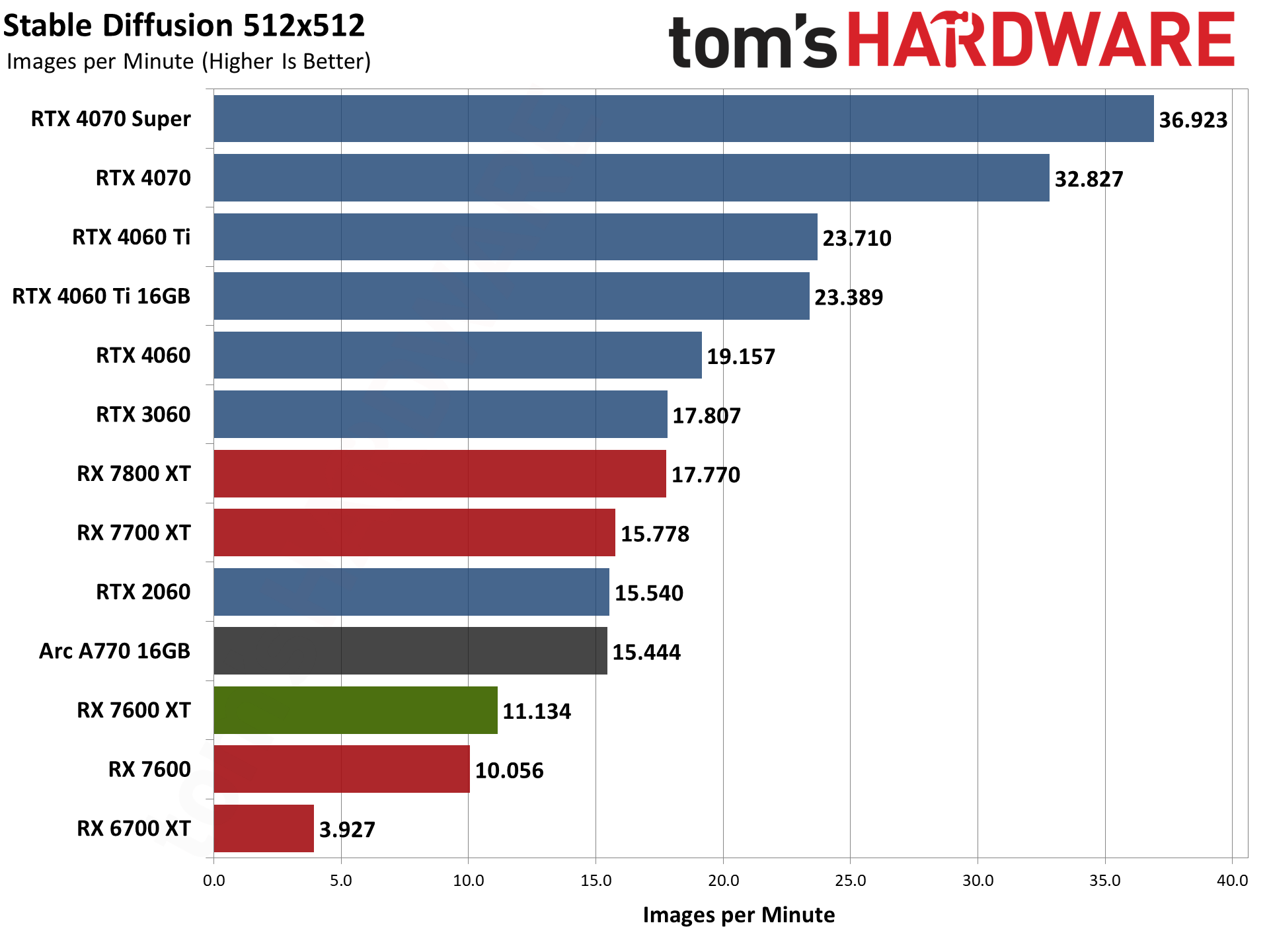
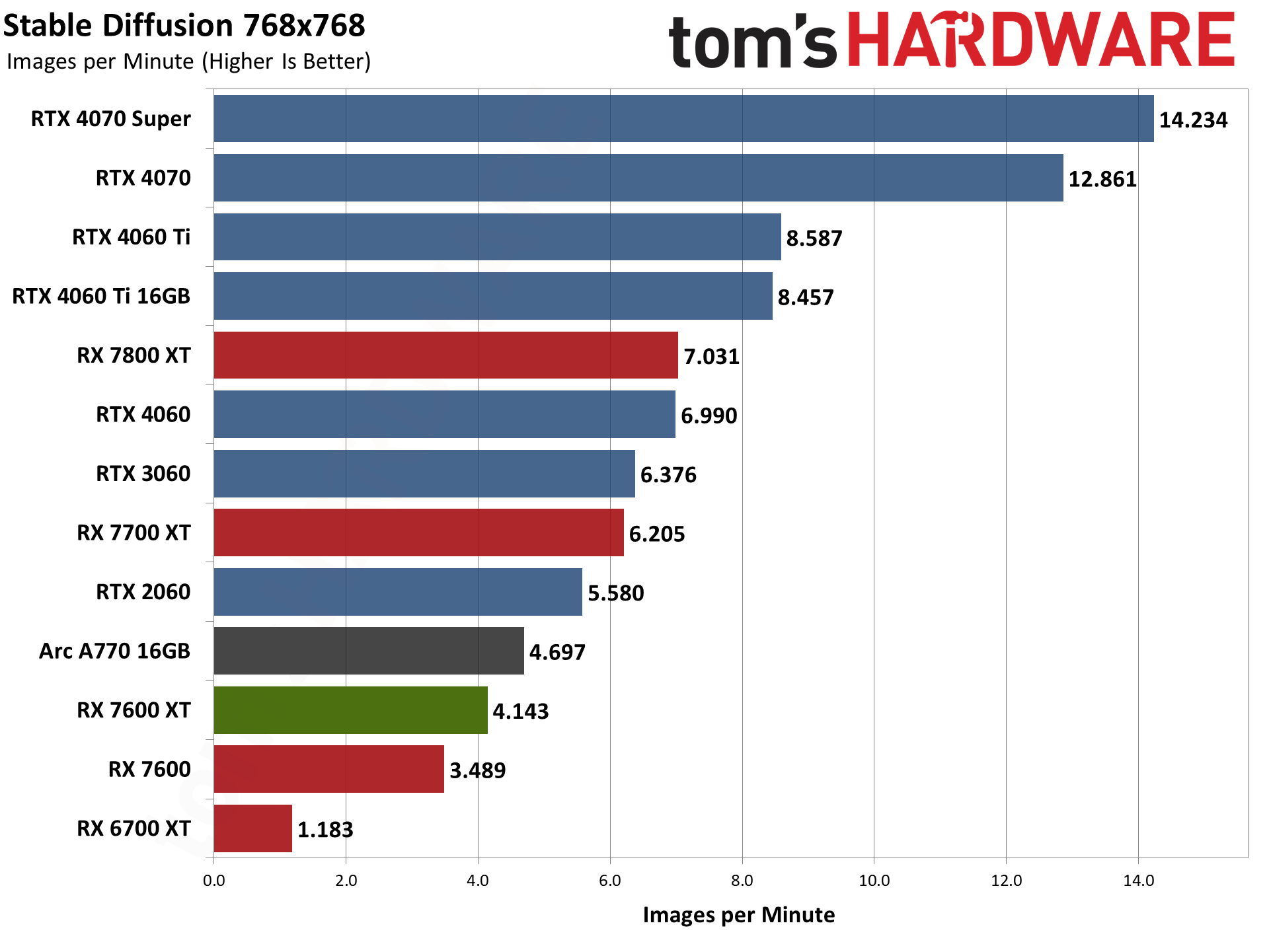
First, let's address the big fat LLM-ephant in the corner: We're not using models that require more than 8GB, or even more than 4GB in some cases. Time constraints have prevented us from getting SDXL up and running in a reasonably tuned fashion on the various GPUs, but that's something we're still looking at testing. AMD also showed the RX 7600 XT running the LLaMa 13b model, where the 7600 8GB card could only manage the 7b model. That's something else we want to figure out how to benchmark in a meaningful fashion, but those will have to come in future articles.
If you happen to fall into the niche of people that want to play with AI models that require a 16GB card, and you're willing to use AMD hardware for the purpose, the RX 7600 XT could be the inexpensive option you're looking for. If you want higher performance AI, naturally that will mean opting for a higher performance GPU like the 7800 XT. So this is perhaps for the "cheap AI GPU" market.
In our Stable Diffusion 512x512 and 768x768 testing, the RX 7600 XT takes up its usual spot that's slightly ahead of the RX 7600. SDXL at present needs more than 8GB on AMD GPUs, so that's something you can't do on the vanilla 7600. AMD's AI accelerator in RDNA 3 helps as well, and the DirectML code doesn't seem to like RDNA 2 GPUs all that much, so this is one of those cases where the 7600 XT also clearly beats the prior generation RX 6700 XT — and in fact it even beats the top RX 6950 XT if you're trying to use DirectML in our experience.
The problem is that Nvidia's GPUs are still significantly faster, not to mention being more widely supported by the community projects we've seen. Even the old RTX 2060 delivers quite a bit more image throughput than the RX 7600 XT in Stable Diffusion. We'll have to see if we can get SDXL running on these cards, but the TensorRT extension has greatly reduced memory footprints for the regular SD1.5 and SD2.1 models, and we wouldn't be surprised to find SDXL working just fine on Nvidia's RTX 2060 even though it only has 6GB of VRAM.
AMD RX 7600 XT Professional Workloads
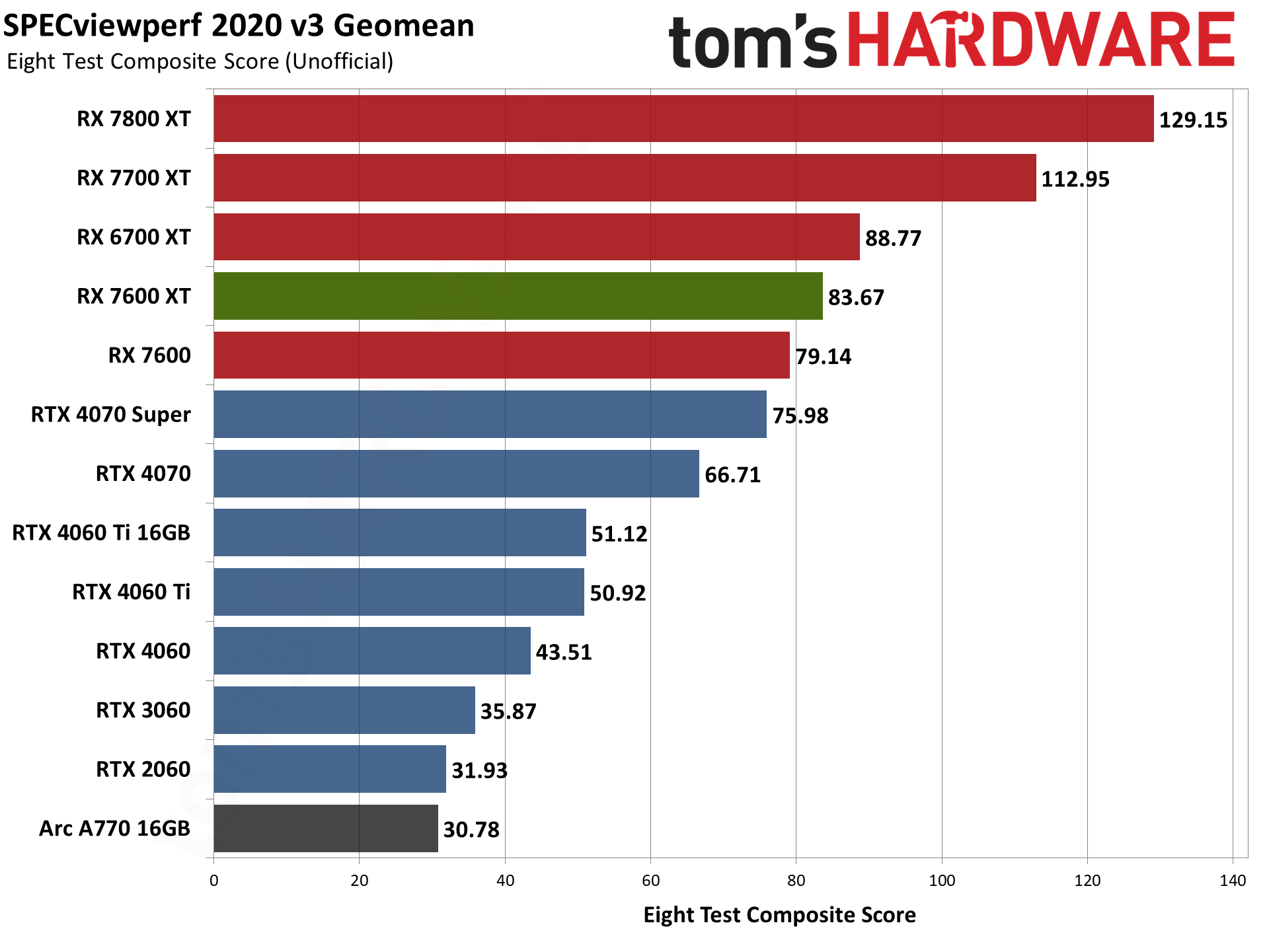
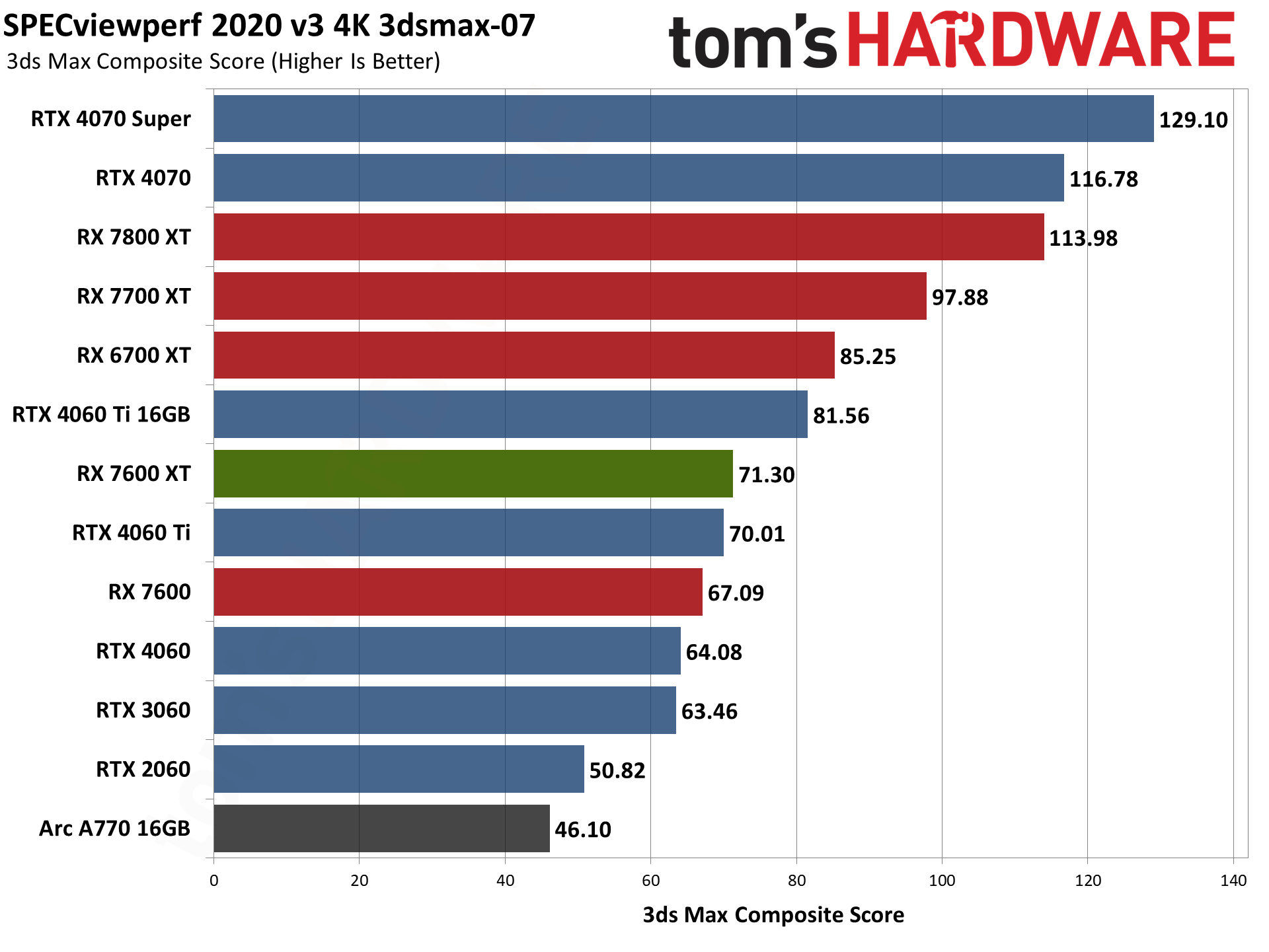
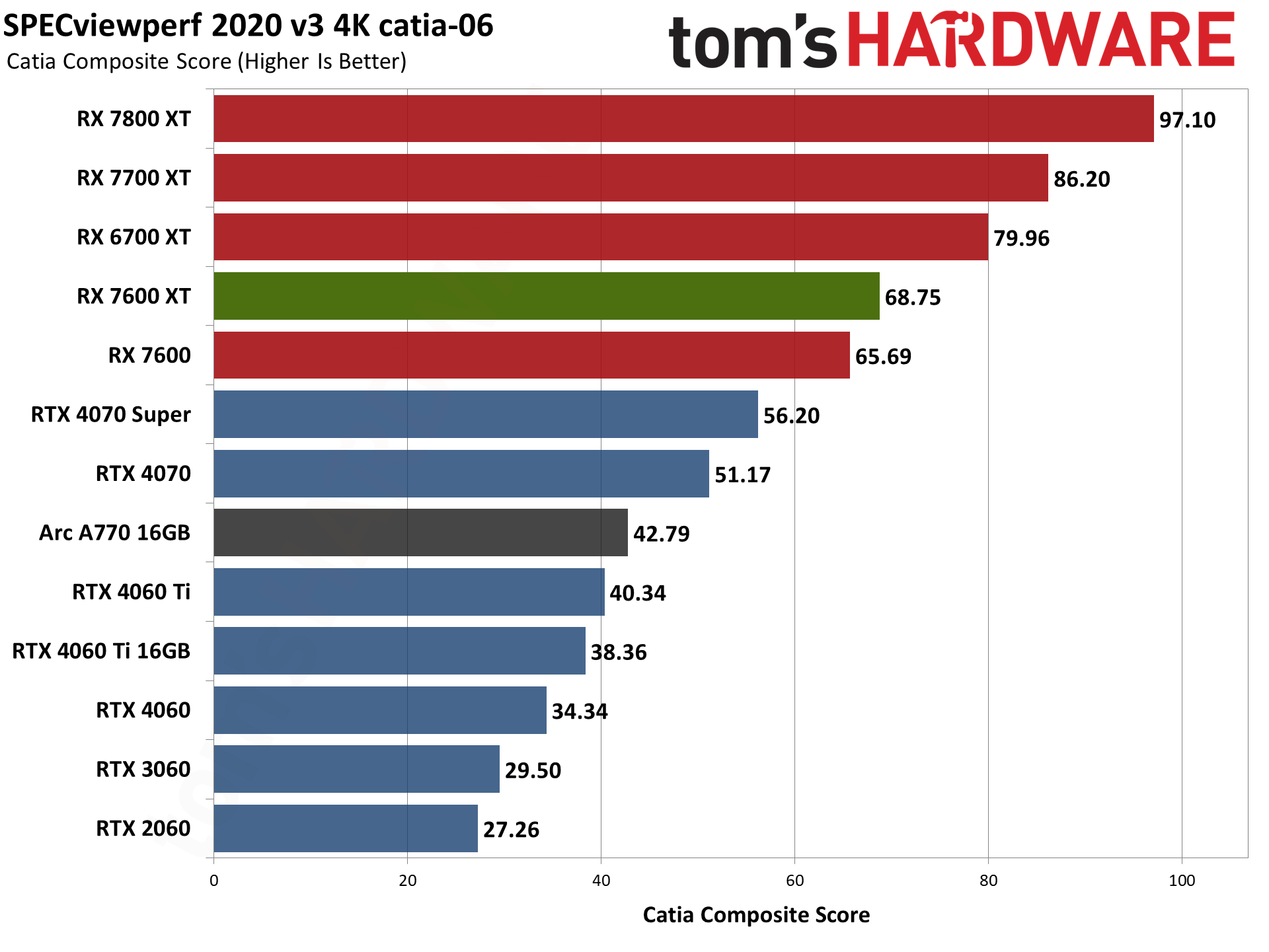


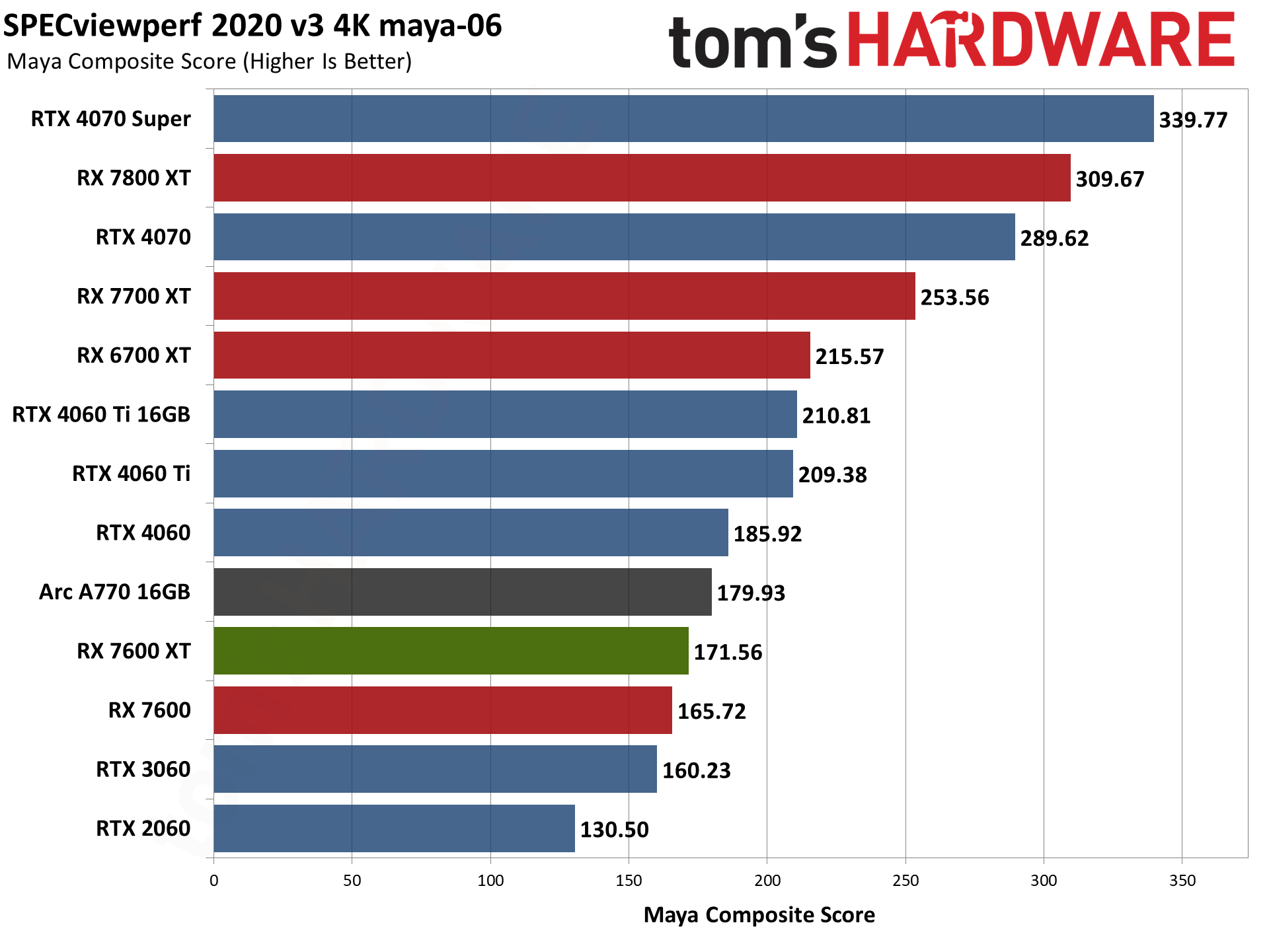
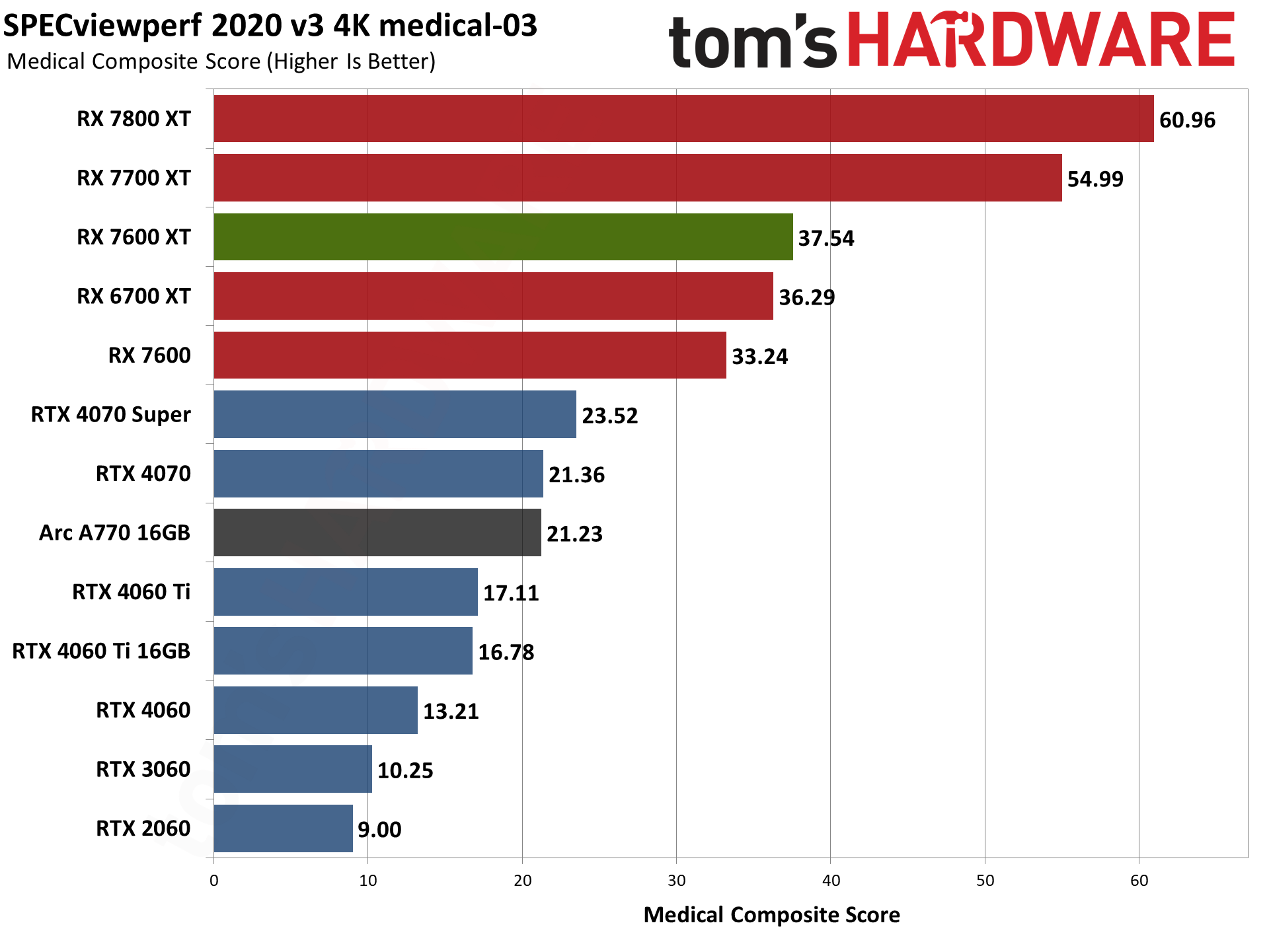
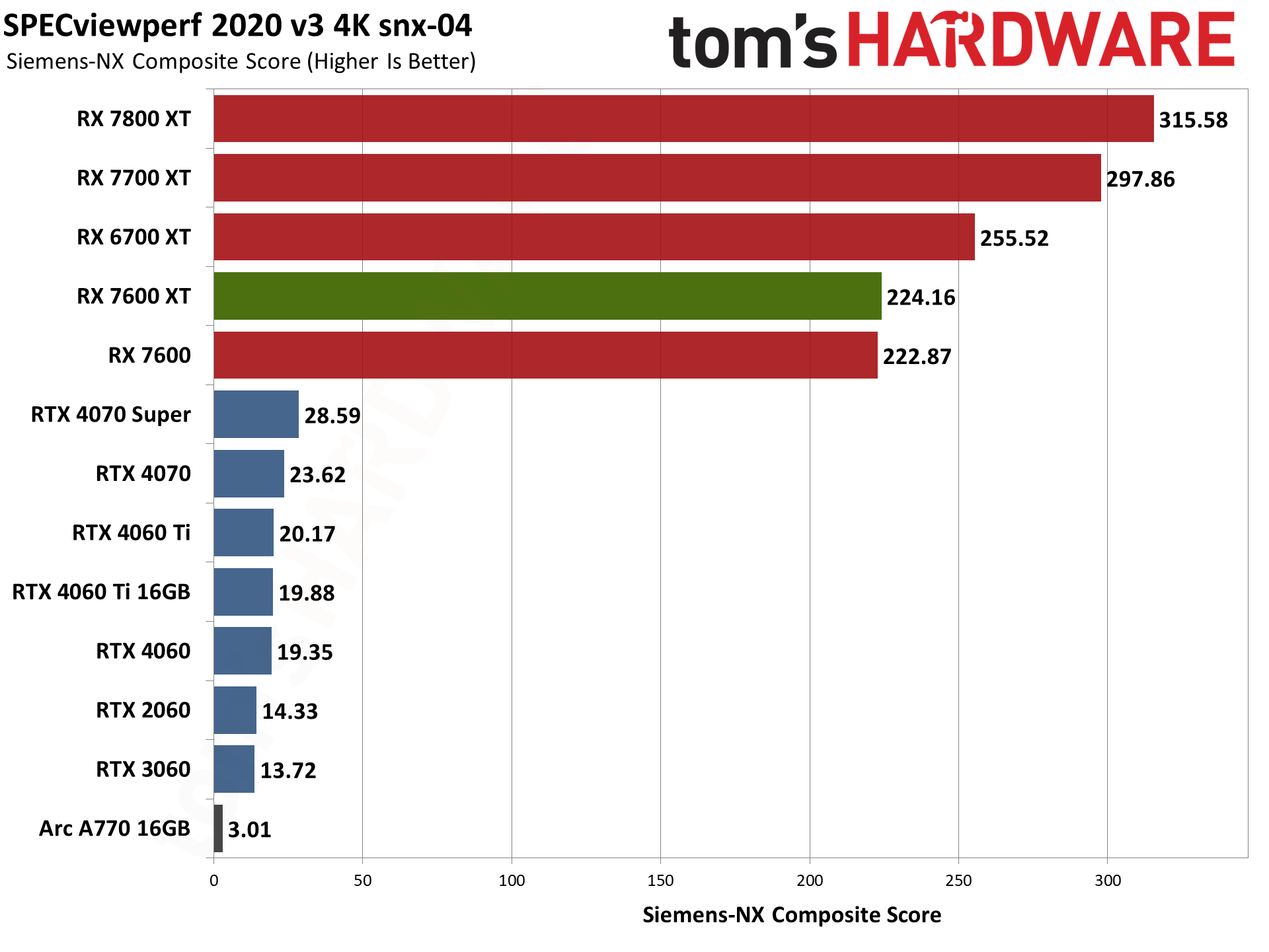

We use SPECviewperf 2020 v3 to assess professional workstation graphics performance on the various GPUs. Nvidia only offers full performance tuning in its drivers for professional GPUs like the RTX 4000/5000 Ada Generation, while AMD tends to be more forthcoming with driver tuning for its consumer cards. This shows up quite clearly in the charts, with AMD's lowest 7000-series GPU still coming in ahead of the RTX 4070 Super.
Several of the SPECviewperf workloads are quite favorable for AMD GPUs — Siemens NX (snx-04) in particular. If you're planning to run one of those applications on a consumer GPU, the RX 7600 XT does quite well considering professional GPUs often cost several thousand dollars. But like the 4K testing results, for a mainstream GPU like the 7600 XT, most of these charts are more for the curious than something that's truly meaningful to the majority of users.
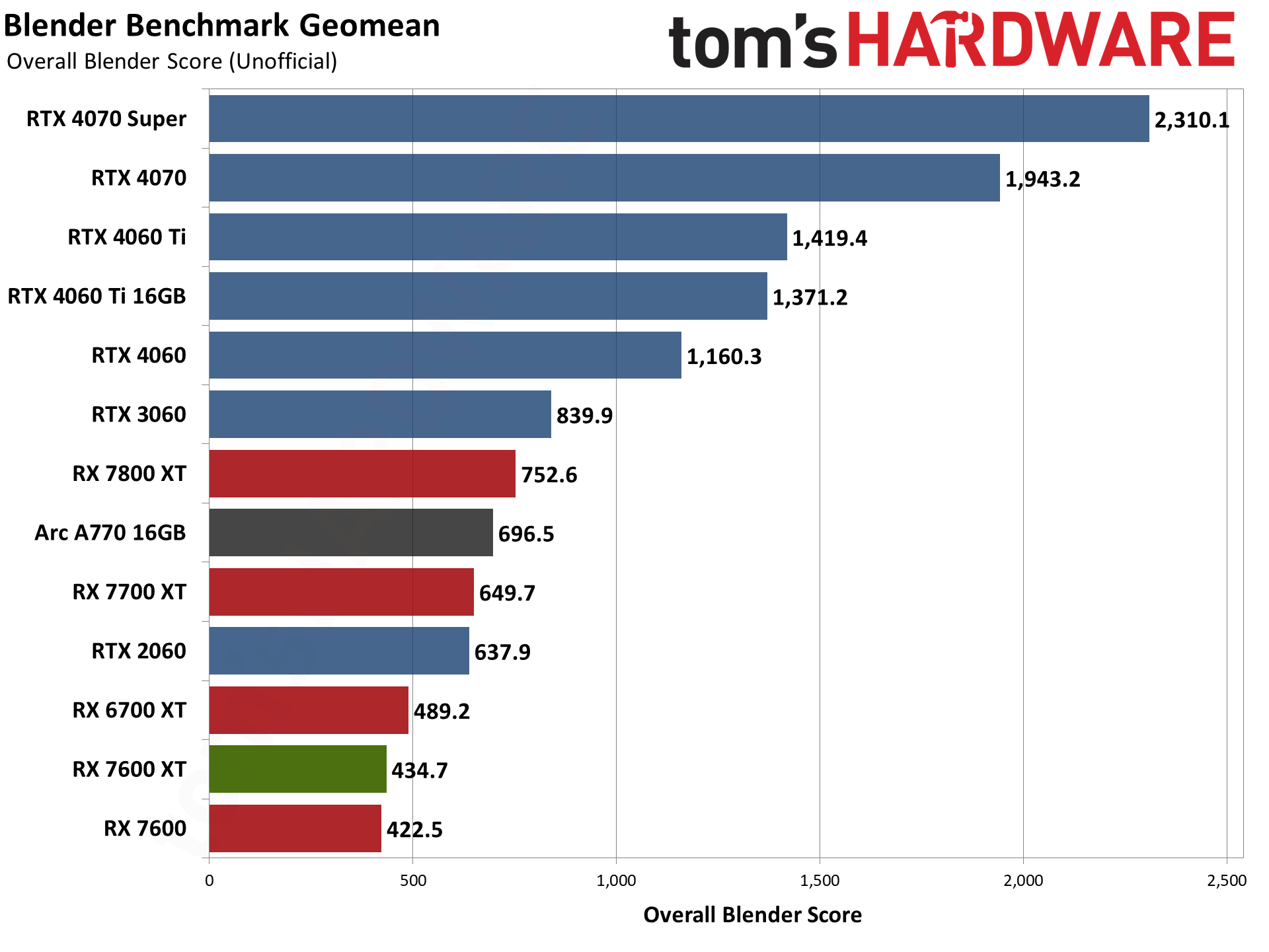

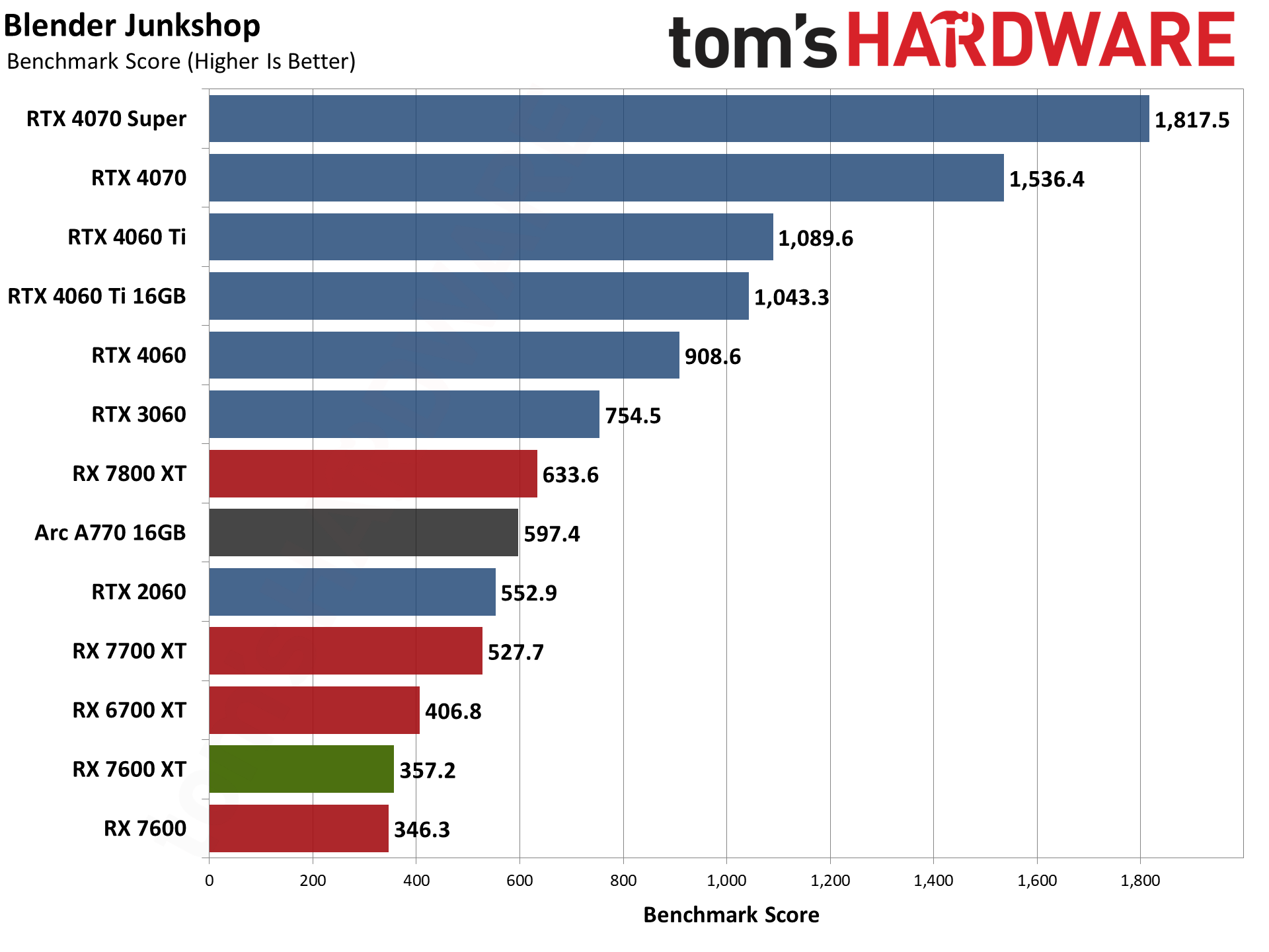
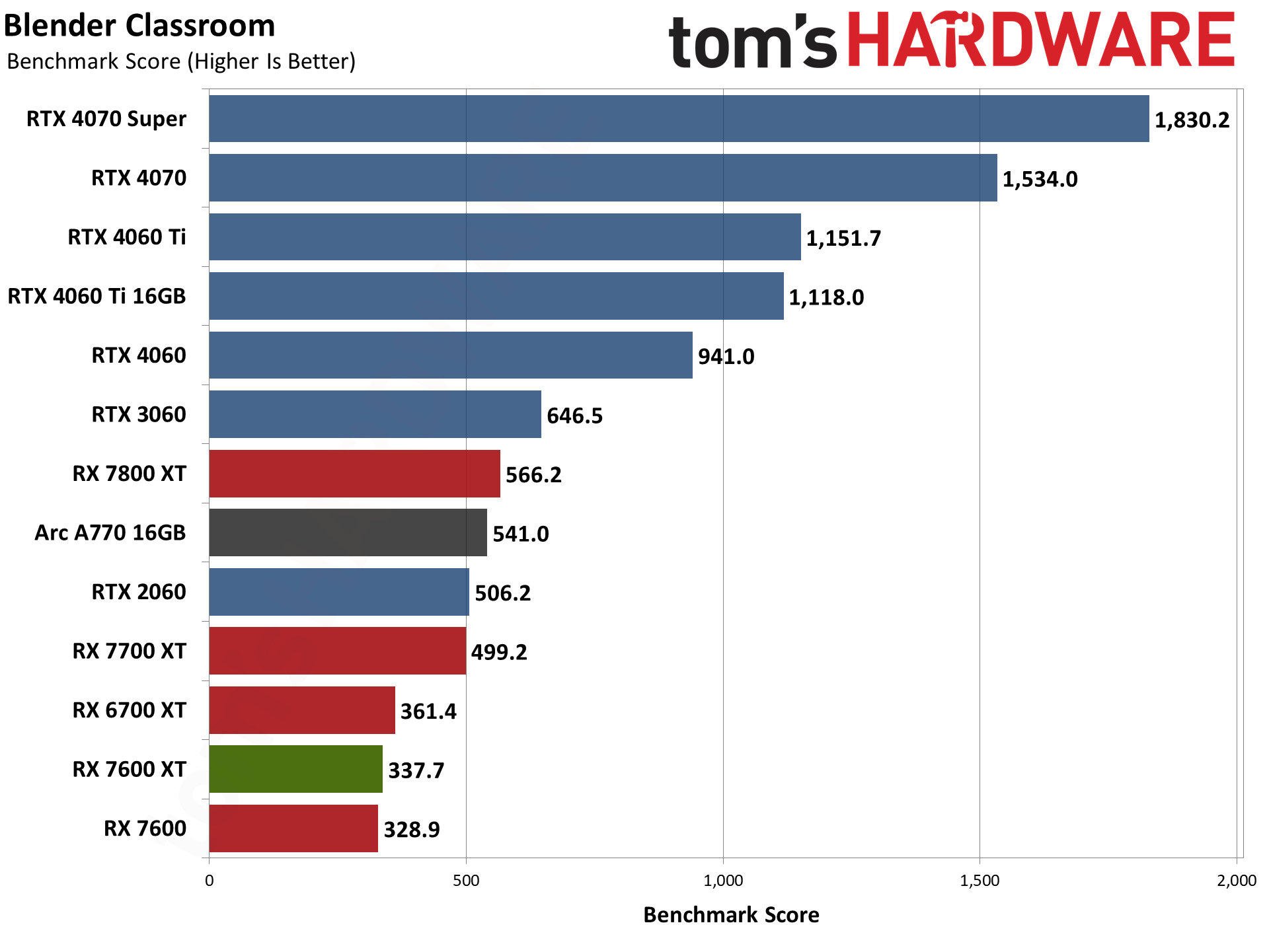
For GPU-accelerated 3D rendering, the only app that currently supports all three GPU vendors is Blender. It now leverages the ray tracing hardware to boost performance, and that generally puts Nvidia in the pole position. We're using Blender Benchmark, version 3.6.0, though version 4.0.0 is also available. We've found some GPUs, including all of the Nvidia models, perform better with version 3.6.0, and it's not clear whether 4.0.0 executes the same workload or if it does extra calculations to deliver a better result.
As we saw in our ray tracing gaming tests, Nvidia's GPUs come out far ahead of AMD's competing offerings. The RX 7600 XT does come out just ahead of the RX 7600, but that's all it can say. The RX 6700 XT delivers moderately better performance, while the RTX 4060 is well over twice as fast.
AMD RX 7600 XT Content Creation Summary
Professional workloads aren't normally the primary use case for consumer GPUs. Yes, you can run them, and some of them do just fine, but content creation professionals will usually opt for the additional support and performance offered by professional GPUs — or at least their employers will.
AI workloads on the other hand are mostly limited by one of two things: raw compute, or the amount of VRAM available. For workloads that fit within the memory of a consumer GPU, such cards are often faster than 'professional' solutions, since they have higher clocks and power limits.
The RX 7600 XT does have some potential interest for AI workloads in that it has 16GB of VRAM and only costs $329. Nvidia's cheapest 16GB card costs $449 by way of comparison. But there's still generally far better support for AI tools and projects on Nvidia hardware, so like we said earlier, this is a very specific niche you'd need to want to play in.
- MORE: Best Graphics Cards
- MORE: GPU Benchmarks and Hierarchy
- MORE: All Graphics Content
Get Tom's Hardware's best news and in-depth reviews, straight to your inbox.
Current page: AMD RX 7600 XT: Professional Content Creation and AI Performance
Prev Page AMD RX 7600 XT: 4K Gaming Performance Next Page AMD RX 7600 XT: Power, Clocks, Temps, and Noise
Jarred Walton is a senior editor at Tom's Hardware focusing on everything GPU. He has been working as a tech journalist since 2004, writing for AnandTech, Maximum PC, and PC Gamer. From the first S3 Virge '3D decelerators' to today's GPUs, Jarred keeps up with all the latest graphics trends and is the one to ask about game performance.
-
Roland Of Gilead AMD's version of the 4060ti! :rolleyes: Disappointing it comes behind even the Arc770.Reply -
btmedic04 This would have been a much more compelling product had it used a further cut down Navi 32 with 3x mcds, 12gb of vram and a $350ish price point. DisappointingReply -
King_V Reply
Well, AMD's version of the 4060ti 16GB, I would say... although, to be fair, it does give SOME performance benefit over the 7600 non-XT. The 4060 Ti 16GB gave just about nothing over the 4060 Ti 8GB (for gaming purposes, an edge case or two notwithstanding)Roland Of Gilead said:AMD's version of the 4060ti! :rolleyes: Disappointing it comes behind even the Arc770. -
JarredWaltonGPU Reply
I do wonder if AMD may eventually try doing an RX 7700 non-XT with those specs, but realistically I think the total cost of 3xMCD plus the Navi 32 GCD means making such a card and selling it at $350 is a losing proposition.btmedic04 said:This would have been a much more compelling product had it used a further cut down Navi 32 with 3x mcds, 12gb of vram and a $350ish price point. Disappointing -
btmedic04 Reply
Yeah, it's more than likely too expensive to hit a $350 price point and still have any kind of profit margin. One can still dream at least lol.JarredWaltonGPU said:I do wonder if AMD may eventually try doing an RX 7700 non-XT with those specs, but realistically I think the total cost of 3xMCD plus the Navi 32 GCD means making such a card and selling it at $350 is a losing proposition. -
Roland Of Gilead Reply
TrueKing_V said:Well, AMD's version of the 4060ti 16GB, I would say... although, to be fair, it does give SOME performance benefit over the 7600 non-XT. The 4060 Ti 16GB gave just about nothing over the 4060 Ti 8GB (for gaming purposes, an edge case or two notwithstanding) -
usertests +$60 is not a huge premium over the 7600 for the extra memory, but the 7600 is overpriced in the first place.Reply
It's not much slower than the 6700 XT, but the 6700 XT is clearly better and 12 GB VRAM is fine. If you want the 7600 XT to play with AI, good luck.
Get it down to $270-280, what the 6700 10 GB used to cost, and it looks more interesting. Although 6700 XT was as low as $295-300 (new) in Nov-Dec. Something tells me they will run out before they return to that price point.
